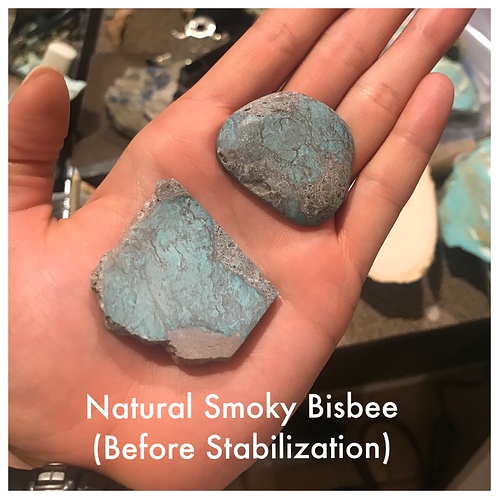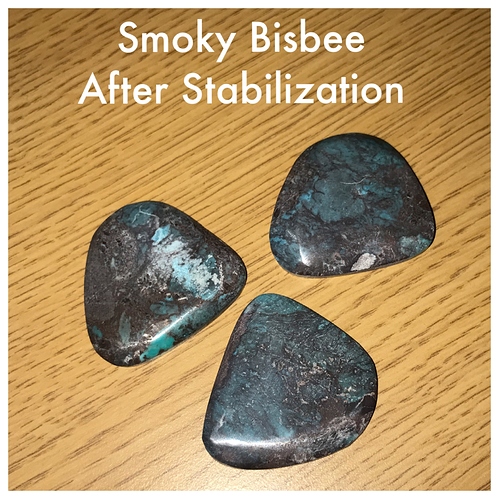I think you have all the information you could ask for now! Lol. I’ll put my two cents in. I feel like I learned a lot about stabilization while on my trip to Arizona. I noticed that a lot of the turquoise I found in the ground was soft enough to break in my hand if I applied enough pressure, and some just crumbled to dust just by picking it up.
I was told that what makes some big name turquoise so expensive and desirable, is not just aways the colors and amazing patterns, It’s the hardness and durability. Some turquoise can be pulled right out of the ground, cut up, and set into jewelry with no stabilization needed. Sometimes, just a simple backing is needed before being set into the jewelry. This is very rare though, and not the case with most turquoise. Most turquoise needs to be stabilized to protect it from breaking or crumbling.
When I talked to the lapidarist, he said that he stabilizes for a few reasons:
-
To make the stone hard & durable. Turquoise is porous, and when soaked in stabilizing solution, soaks it all up and hardens itself throughout. That way when we wear a turquoise ring and accidentally hit it on a hard surface, it makes the stone less likely to break on impact. Have you ever seen turquoise with natural pyrite inclusions? The lapidarist also told me that the stabilizing solution helps keep the pyrite matrix from falling out in chunks when he cabs up the turquoise.
-
To protect color. Since turquoise is porous, it absorbs easily. Body oils, sweat, dirt and other outside factors can accidentally be absorbed by turquoise. This is why turquoise can change color over time (we see this more commonly with older turquoise, before stabilization was widely utilized).
-
To enhance color. Stabilizing brings out the color of turquoise. I was lucky enough to pick out some rough, natural Bisbee, and then the lapidarist stabilized for me. I must say, even though I prefer the color & matrix of the natural Bisbee I picked out, I guess I feel better knowing that it won’t crack in my hand. The lapidarist reminded me that stabilizing enhances the color that the turquoise already has, as opposed to dyeing turquoise, which is meant to intentionally change the color of the stone.
I know I’ve posted these pictures before, but I didn’t really elaborate on the before & after results.
I would agree with Jason that most turquoise set into jewelry is stabilized. Therefore, instead of looking for “natural” turquoise, I think we should look for turquoise that has been stabilized properly. Sometimes, the stabilizing solution is mistaken for quartz matrix. I think that the stabilizing shouldn’t even be noticeable to the untrained eye. On this older necklace (1970’s) that I sold, the stabilizing solution is THICK and I don’t care for it at all. It looks like they dunked each bead into stabilizing solution.
The Heishe strand on the right shows poor stabilization; The stabilizing solution has even turned brown. The Heishe strand on the left however, shows little to no signs of the stabilization process.
So, to summarize:
Pros of stabilizing:
-hardens the stone
-protects the stone from breakage
-prevents color change
Cons:
-can change the stone’s natural color permanently
-poor stabilizing looks like plastic coating. Yuck.
-stabilizing solution can turn yellow/brown over time


